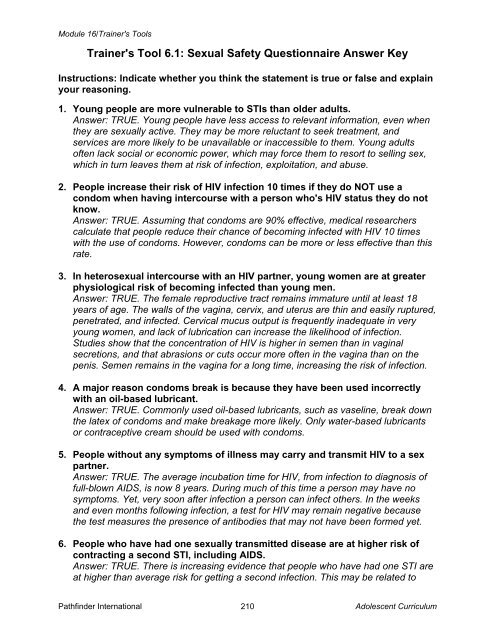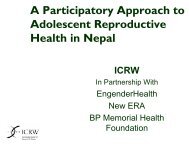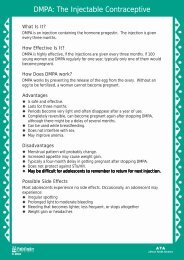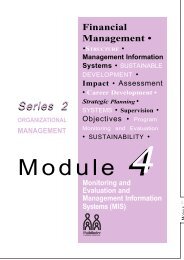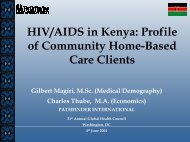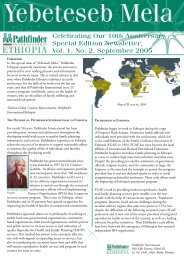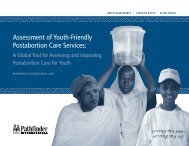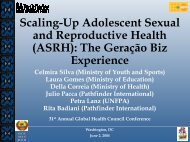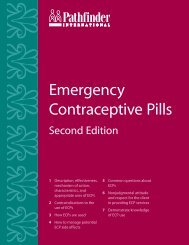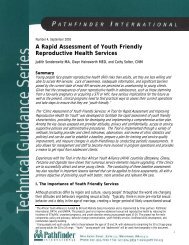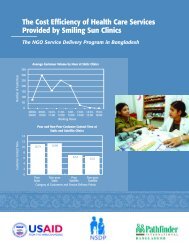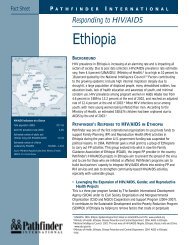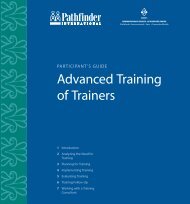reproductive health services for adolescents - Pathfinder International
reproductive health services for adolescents - Pathfinder International
reproductive health services for adolescents - Pathfinder International
Create successful ePaper yourself
Turn your PDF publications into a flip-book with our unique Google optimized e-Paper software.
Module 16/Trainer's Tools<br />
Trainer's Tool 6.1: Sexual Safety Questionnaire Answer Key<br />
Instructions: Indicate whether you think the statement is true or false and explain<br />
your reasoning.<br />
1. Young people are more vulnerable to STIs than older adults.<br />
Answer: TRUE. Young people have less access to relevant in<strong>for</strong>mation, even when<br />
they are sexually active. They may be more reluctant to seek treatment, and<br />
<strong>services</strong> are more likely to be unavailable or inaccessible to them. Young adults<br />
often lack social or economic power, which may <strong>for</strong>ce them to resort to selling sex,<br />
which in turn leaves them at risk of infection, exploitation, and abuse.<br />
2. People increase their risk of HIV infection 10 times if they do NOT use a<br />
condom when having intercourse with a person who's HIV status they do not<br />
know.<br />
Answer: TRUE. Assuming that condoms are 90% effective, medical researchers<br />
calculate that people reduce their chance of becoming infected with HIV 10 times<br />
with the use of condoms. However, condoms can be more or less effective than this<br />
rate.<br />
3. In heterosexual intercourse with an HIV partner, young women are at greater<br />
physiological risk of becoming infected than young men.<br />
Answer: TRUE. The female <strong>reproductive</strong> tract remains immature until at least 18<br />
years of age. The walls of the vagina, cervix, and uterus are thin and easily ruptured,<br />
penetrated, and infected. Cervical mucus output is frequently inadequate in very<br />
young women, and lack of lubrication can increase the likelihood of infection.<br />
Studies show that the concentration of HIV is higher in semen than in vaginal<br />
secretions, and that abrasions or cuts occur more often in the vagina than on the<br />
penis. Semen remains in the vagina <strong>for</strong> a long time, increasing the risk of infection.<br />
4. A major reason condoms break is because they have been used incorrectly<br />
with an oil-based lubricant.<br />
Answer: TRUE. Commonly used oil-based lubricants, such as vaseline, break down<br />
the latex of condoms and make breakage more likely. Only water-based lubricants<br />
or contraceptive cream should be used with condoms.<br />
5. People without any symptoms of illness may carry and transmit HIV to a sex<br />
partner.<br />
Answer: TRUE. The average incubation time <strong>for</strong> HIV, from infection to diagnosis of<br />
full-blown AIDS, is now 8 years. During much of this time a person may have no<br />
symptoms. Yet, very soon after infection a person can infect others. In the weeks<br />
and even months following infection, a test <strong>for</strong> HIV may remain negative because<br />
the test measures the presence of antibodies that may not have been <strong>for</strong>med yet.<br />
6. People who have had one sexually transmitted disease are at higher risk of<br />
contracting a second STI, including AIDS.<br />
Answer: TRUE. There is increasing evidence that people who have had one STI are<br />
at higher than average risk <strong>for</strong> getting a second infection. This may be related to<br />
<strong>Pathfinder</strong> <strong>International</strong><br />
210<br />
Adolescent Curriculum


